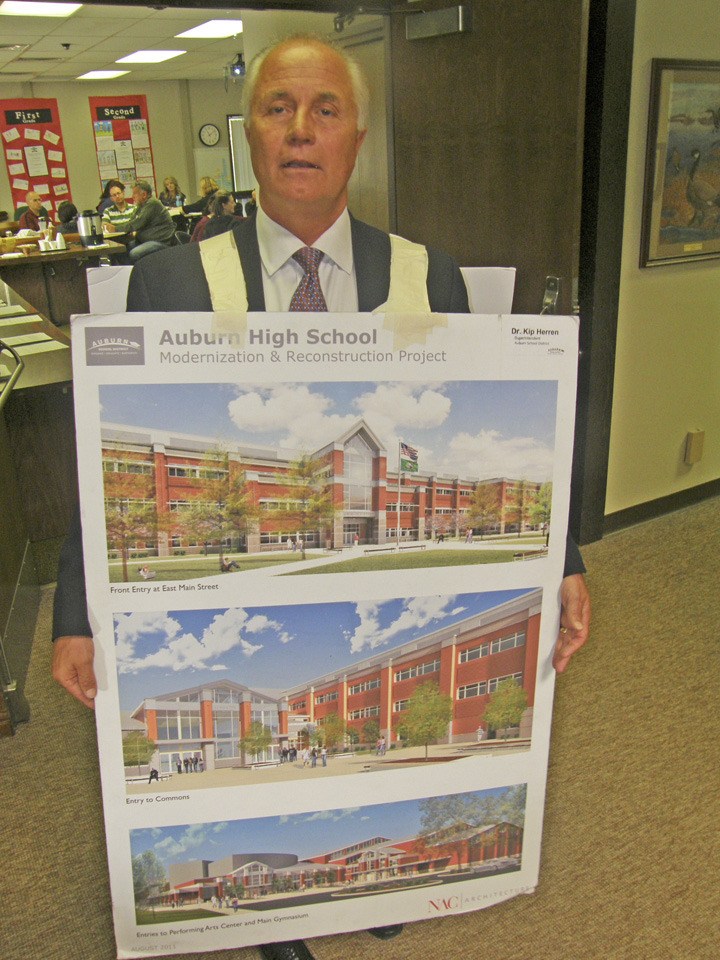On most days Auburn School District Superintendent Kip Herren sports a respectable suit — often, gunmetal gray, spiffy tie.
But lately Herren has been spotted at public meanings in, shall we say, dress-down duds — a two-piece, wooden sandwich board slung over those spiffy threads. On one side of the board, images of 62-year-old Auburn High School, weary boilers, cracked ceilings, outdated electrical systems, sundry wrinkles, age spots. On the other, Auburn High School as it could be a state-of-the-art, three-story building facing East Main Street, with a sharp red brick exterior and spanking new interior ventilation and heating systems.
“I ask kids I see what school they would like to go to, and they say, ‘that one,'” Herren said, pointing to an artist’s rendering of the proposed Auburn High School, “but their parents went to that one,” he added, pointing to present high school.
Herren slips into that sandwich board with pride because he wants everyone to know about the $110 million Auburn High School modernization and reconstruction bond measure on the Nov. 6 general election ballot.
Wants them to know why it matters so much.
It matters, he said, because the aging AHS is longer cost-effective to operate and maintain. Critically needed repairs include leaking roofs, poor air quality and ventilation and outdated classrooms and labs. Those geezer systems are costing the district $250,000 more in energy costs per year than all the other schools.
District officials realize that some supporters are wary of putting the measure on the fall general election ballot, where it will complete not only with the presidential election but with various referenda and initiatives.
“We’re figuring we want as many members of the community that voted in the last election as we can get. We want a big turnout. We figure this is the issue at the local level, and we want everybody to have a say,” Herren said.
Results of the two previous attempts give supporters hope. When the district first ran the bond in 2009, it garnered 46-percent of the vote, 14 percentage points below the supermajority state law requires for bond measures to pass. In the Feb. 14 2012 special election, it garnered 55.2 percent.
The plan and the district’s pitch to the public are about what they were last winter:
• School taxes will stay level.
• The district has refinanced it previous bonds, saving taxpayers $3 million.
• The district bond debt for schools is at an all-time low.
• The project is eligible for $25 million in state matching funds.
• The new school would save $250,000 annually in energy.
• Delay of the project will cost $3 million more annually.
• Construction prices are at a record low.
• It will create jobs within the community.
Money from the bond sale, added to $10 million from the school district’s capital projects fund, would pay for the project, Herren said.
“It is a dilemma for folks on fixed incomes when there are taxes, period. It is tough. That’s why discounts are available for seniors who experience the hardship of a low, stable income. They can get reductions in their school tax. But I can’t control all the taxation. All the board can control is our baileywick of taxes. Last time we had almost 20 people contact us say, ‘how can you do this taxwise,’ and our answer is because we have retired other bonds,” Herren said.
Plans show the construction footprint extending north from East Main over today’s tennis courts and parking lot toward the Performing Arts Center. Accordingly, all community activities — ball park, pool, gym, the PAC and the stadium — would be clustered on the north side of the campus.
Buses would enter from East Main Street and load or unload entirely on campus, a safety improvement over the traffic that today spills onto 4th Street today, tying up traffic and endangering lives, Herren said.
Plans call for the PAC to get a new lobby, one facing 4th Street. The lobby would provide handicapped access to the top floor, the stage and the upstairs bathrooms. All of the school’s music programs would be tied to the PAC.
The three-story, red brick school would be set 100-feet back from East Main.
One benefit to rebuilding and not remodeling, Herren said is that students could stay at the current school during the construction period. On the other hand, remodeling of the present high school would take two years, and the district would need to move all of the the students to other schools during that period.
Ultimately the district would level the old high school, replacing it with a 600-stall parking lot, 300 more parking places than are available today. Without the high school in the way of the PAC people coming for a performance could spot the building more easily.
====
MEETING, TOURS
• What: A community meeting for the Auburn High School modernization and reconstruction project
• When: Monday, Oct. 1, guided building tours 5 to 6 p.m., meeting at 6 p.m. provides an opportunity for the community to hear details about the project and ask questions.
• Where: The Auburn High School Library.
Visit the Auburn High School Modernization and Reconstruction website for more information about the project at ahsproject.auburn.wednet.edu.


